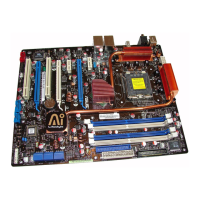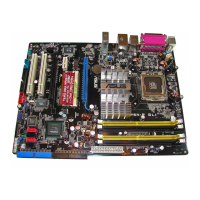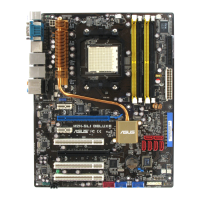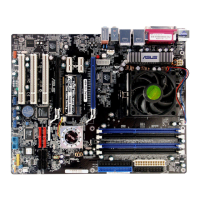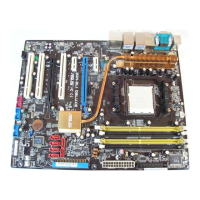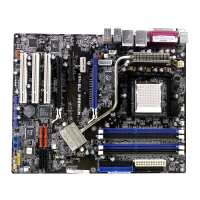Do you have a question about the Asus P5N32-E SLI Plus and is the answer not in the manual?
Welcome message and instructions to check for included accessories.
Lists all components included in the motherboard package.
Details motherboard features like Green ASUS, Intel Core, NVIDIA nForce, SLI, DDR2.
Precautions and guidelines before installing the motherboard to prevent static damage.
Overview of the motherboard, including mounting orientation and screw hole locations.
Details about the LGA775 socket and CPU installation precautions.
Step-by-step guide for installing the CPU into the LGA775 socket.
Instructions for installing the CPU heatsink and fan.
Steps to safely remove the CPU heatsink and fan.
Guide for installing an optional quiet fan with passive heatsinks.
Information about the motherboard's DDR2 memory slots and specifications.
Overview of the DDR2 DIMM memory module slots and their specifications.
Guidelines for selecting and configuring memory modules for dual-channel operation.
Step-by-step instructions for installing memory modules into the DIMM slots.
Steps to safely remove memory modules from the DIMM slots.
Information about the motherboard's expansion slots for add-in cards.
Instructions on how to install expansion cards into the available slots.
Steps to configure expansion cards after installation, including BIOS settings and drivers.
Explanation of IRQ assignments and a table of interrupt requests for motherboard devices.
Details on PCI and PCI Express slots, including SLI support.
Explanation of jumper settings on the motherboard, including CMOS clearing.
Step-by-step guide for installing an audio card into a PCI-E slot.
Description and diagram of the rear panel I/O connectors.
Description of internal connectors on the motherboard, like floppy and IDE.
Steps for the initial power-on and boot process, including checks and BIOS entry.
Procedures for shutting down the computer using the operating system or power button.
Overview of BIOS management tools and procedures for updating the BIOS.
Introduction to the BIOS setup program and its interface.
Details of the Main menu options for system time, date, and language.
Settings for IDE devices, including PIO and UDMA modes.
Configuration for SATA devices, including extended drive and access mode settings.
Option to enable or disable hard drive self-monitoring.
Displays the installed memory capacity.
Displays the usable memory capacity.
Menu for CPU overclocking and system frequency adjustments.
Menu for configuring advanced system settings.
Menu for configuring power management features like ACPI and APM.
Settings for boot device priority and boot behavior.
Access to utility tools like ASUS Music Alarm and BIOS profile management.
Options for saving changes, discarding changes, or loading default BIOS settings.
Requirements for installing operating systems like Windows on the motherboard.
Information about the drivers and utilities included on the support CD.
Detailed explanation of the software applications included on the support CD.
Explanation of RAID levels and their functionalities.
Steps to create a floppy disk with RAID drivers for OS installation.
Introduction to NVIDIA SLI technology and its support on the motherboard.
Instructions for installing and configuring multiple graphics cards for SLI.
| ECC | No |
|---|---|
| Non-ECC | Yes |
| Number of memory slots | 4 |
| Maximum internal memory | 8 GB |
| Processor socket | LGA 775 (Socket T) |
| Processor manufacturer | Intel |
| Maximum number of SMP processors | 1 |
| USB 2.0 connectors | 3 |
| Number of SATA connectors | 6 |
| Special features | ASUS EZ DIY ASUS MyLogo3 ASUS Q-Fan 2 |
| Manageability features | WOL by PME, WOR by PME, PXE |
| Controller interface type | Serial ATA I/II |
| Controller 2nd interface type | UltraDMA 133/100/66/33 |
| PS/2 ports quantity | 2 |
| USB 2.0 ports quantity | USB 2.0 ports have a data transmission speed of 480 Mbps, and are backwards compatible with USB 1.1 ports. You can connect all kinds of peripheral devices to them. |
| Audio chip | ADI AD1988B |
| Audio output channels | 7.1 channels |
| Motherboard form factor | ATX |
| Bundled software | Drivers ASUS PC Probe II ASUS Update ASUS AI Booster NVIDIA MediaShield RAID Anti Virus (OEM) |
| Networking features | Dual Gigabit Ethernet |
| BIOS memory size | 64 Mbit |
| RAID levels | 0, 1, 0+1, 5, JBOD |
| Depth | 245 mm |
|---|---|
| Width | 305 mm |
